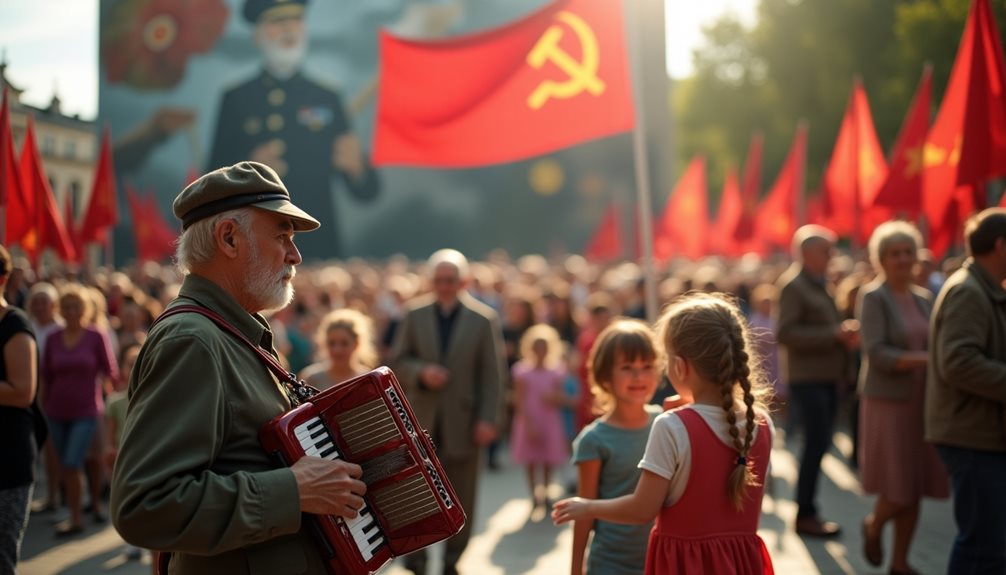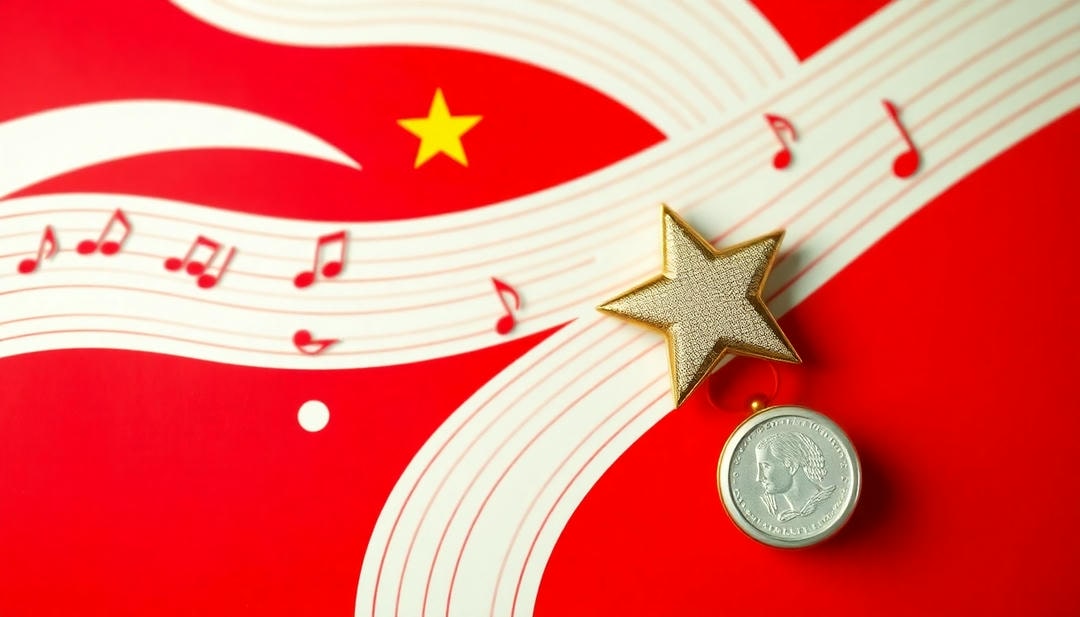Enduring Soviet Songs

Though the Soviet Union has long since dissolved, its anthems celebrating the Motherland continue to hold a special place in Russian culture. These powerful songs evoke a deep sense of pride and unity, connecting generations through shared history and collective memory.
The lyrics often highlight themes of resilience, strength, and the beauty of the homeland, inspiring a renewed appreciation for Russia’s rich heritage. Their melodies, familiar and stirring, serve as a bridge between past and present, helping Russians navigate their identity in today’s world.
Soviet-era patriotic songs are more than just music; they are cultural treasures that reflect the spirit and aspirations of the nation. They foster emotional bonds and national pride, reminding listeners of the enduring strength and unity that characterize Russia.
Even now, these anthems continue to resonate widely, symbolizing a cultural revival that honors the past while inspiring future generations. Their lasting influence underscores the importance of music as a powerful expression of Russian identity and heritage.
Thematic Pillars of Soviet Patriotic Songs

Patriotism is a central theme in Soviet-era songs, expressed through melodies that celebrate national pride and unity. These songs played a vital role in bringing people together, especially during challenging times, and their influence continues to shape Russian culture today.
A key feature is the admiration for the Soviet worker, youth, and collective achievements. Songs often honor the dedication of workers and the enthusiasm of young people, highlighting their contributions to the nation’s progress. By celebrating collective accomplishments, these anthems inspire a strong sense of purpose and unity within society.
The beauty and vastness of the Russian landscape are also common motifs. Lyrics evoke images of majestic mountains, endless plains, and flowing rivers, deepening the emotional bond between the people and their homeland. This romantic portrayal of nature fosters national pride and a shared love for Russia’s land.
Soviet songs are cherished for their ability to capture the spirit of resilience, hope, and togetherness. Through these enduring melodies, generations connect with their heritage and draw inspiration from the values that continue to define Russian identity.
Iconic Songs and Their Stories
While the Soviet era produced a multitude of anthems, certain iconic songs stand out not only for their musical composition but also for the profound narratives and historical contexts they encapsulate.
Songs like “Katyusha” and “The Sacred War” reflect the songwriters’ influences drawn from folklore and revolutionary zeal, intertwining personal stories with collective memory.
These compositions emerged during tumultuous times, serving as rallying cries that fostered national pride and unity.
Their enduring resonance highlights a complex interplay between art and politics, illustrating how music can reflect the aspirations of a people while maneuvering the intricacies of historical contexts.
Anthem of the Young Pioneers (1922)

The “Anthem of the Young Pioneers,” first introduced in 1922, quickly became a symbol of youthful optimism and collective ambition in the Soviet Union. Crafted by Aleksandr Zharov and Sergey Kaidan-Deshkin at the request of Nadezhda Krupskaya, the anthem encouraged unity and inspired generations of young people to pursue knowledge, friendship, and perseverance.
Fostering Unity and Belonging
Through uplifting lyrics and a stirring melody, the anthem fostered a strong sense of belonging among Soviet youth. It highlighted the importance of teamwork, discipline, and readiness, motivating children to see themselves as active contributors to a brighter future.
Celebrating Values and Aspirations
The anthem celebrated values such as friendship, resilience, and dedication. By promoting these ideals, it helped shape the character of young citizens and encouraged them to strive for excellence in all aspects of life.
Cultural and Historical Significance
As a cherished part of Russian cultural heritage, the “Anthem of the Young Pioneers” remains a testament to the enduring spirit of youth and the power of music to unite and inspire. Its legacy continues to resonate, reflecting the strength and aspirations of generations past and present
Wide is My Motherland (1936)
A Patriotic Masterpiece: “Wide is My Motherland,” composed by Isaac Dunaevsky with lyrics by Vasily Lebedev-Kumach, stands as a beloved symbol of Russian musical heritage. Debuting in the 1936 film Circus, the song quickly captured the hearts of audiences with its vivid celebration of the nation’s vast landscapes and diverse regions.
Symbol of Unity and Freedom
The lyrics evoke the beauty and breadth of Russia, from forests and fields to mountains and seas, highlighting a land where people live freely and proudly. The song’s message of unity and resilience resonates across generations, reinforcing a strong sense of national identity.
Cultural Significance in Film and Radio
Featured prominently in Circus, the anthem underscored themes of hope and belonging, culminating in a memorable May Day parade scene on Red Square. Its popularity soared, and in 1939, its opening chorus became the official call sign of Soviet radio, further embedding it into daily life and cultural memory.
Enduring Legacy
Over the years, “Wide is My Motherland” has been translated into numerous languages and remains a cherished patriotic song in Russia today. Its enduring appeal lies in its ability to inspire pride, unity, and a deep connection to the Russian homeland, making it a timeless piece of national culture.
Moscow in May (1937)
“Moscow in May,” composed in 1937 by Dmitri Pokrass with lyrics by Vasily Lebedev-Kumach, is a vibrant anthem that captures the spirit of spring and renewal in the heart of Russia’s capital. Written for the documentary The Twentieth May, it commemorated the 20th anniversary of the Soviet state, reflecting a time of cultural revival and national pride.
Evoking Moscow’s Grandeur
The song’s opening lines paint a vivid picture of the Kremlin bathed in morning light, symbolizing the awakening of the entire nation. Its melodies and lyrics celebrate Moscow’s beauty and strength, inspiring unity and a shared sense of purpose among listeners.
Unity and Collective Spirit
“Moscow in May” became a rallying anthem, reinforcing a collective identity rooted in resilience and progress. It honors the dedication and heroism of the people, fostering solidarity through references to labor and shared destiny. The anthem’s imagery of the Kremlin stands as a powerful emblem of national pride and unity.
Enduring Cultural Legacy
Performed by choirs across generations, the song remains a cherished part of Russia’s musical heritage. Its stirring melody and evocative words continue to inspire pride in the homeland and a connection to the enduring spirit of Moscow and the Russian people.
March of the Enthusiasts (1940)
Spirit of Collective Progress
Composed in 1940 by Isaak Dunayevsky for the film The Bright Way, “March of the Enthusiasts” celebrates the energy and unity of the people dedicated to advancing their homeland. Its uplifting melody inspires a shared sense of purpose and pride in collective achievement.
Inspiring Transformation
The song accompanies a narrative of ordinary citizens rising to heroic status, reflecting resilience and determination. It highlights the strength found in community and the potential within every individual to contribute to the nation’s bright future.
Honoring Industrial Triumphs
“March of the Enthusiasts” pays tribute to the remarkable industrial progress that shaped the country’s growth. Through rhythmic, powerful music, it honors the dedication of workers and youth, emphasizing their vital role in building a prosperous and united nation.
Enduring Cultural Legacy
This anthem remains an inspiring symbol of enthusiasm and solidarity, reminding listeners of the transformative power of collective effort and the enduring spirit of the Russian people.
March of the Communist Brigades (1958)
Anthem of Collective Spirit
Emerging in 1958, “March of the Communist Brigades” captures the vibrant energy and unity of a society dedicated to rebuilding and progress. Its stirring melody reflects the shared commitment of workers and youth striving toward a brighter future.
Post-War Renewal and Youth Role
The song honors the resilience of the post-war era, highlighting the vital contributions of Komsomol youth in national projects. These young volunteers embodied determination and optimism, playing a key role in revitalizing the country’s economy and infrastructure.
Celebrating Shared Achievements
Through powerful lyrics and uplifting music, the anthem celebrates collective effort and the spirit of cooperation. It fosters pride in labor and the belief that every citizen’s dedication is essential to the nation’s success.
Enduring Inspiration
“March of the Communist Brigades” remains a timeless symbol of solidarity and progress, inspiring generations with its message of unity and the transformative power of working together for the common good.
Song of a Turbulently Spent Youth (1958)
Capturing the Spirit of a Generation
Released in 1958, “Song of a Turbulently Spent Youth” reflects the vibrant energy and emotional complexity of young people in the Soviet Union during a time of significant change. The song channels both the optimism and the challenges faced by a generation navigating new freedoms and shifting social expectations.
Resonating with Youthful Experience
The lyrics evoke the exuberance of youth while also inviting reflection on the obstacles and uncertainties of the era. This duality mirrors the experiences of many young Soviets, who were eager to embrace new opportunities yet mindful of the difficulties that came with rapid transformation. The song’s themes of aspiration, resilience, and searching for meaning resonated deeply, making it a touchstone for those coming of age in a dynamic society.
A Cultural Landmark
As a musical artifact, the song stands as a testament to the evolving identity of Soviet youth. It captures the interplay between tradition and change, illustrating how young people contributed to the cultural richness and diversity of the nation. Through its heartfelt melodies and honest lyrics, “Song of a Turbulently Spent Youth” remains a powerful reminder of the enduring spirit and creativity of Russia’s younger generations.
The Enduring Power of Soviet Patriotic Songs
The legacy of Soviet patriotic music is woven deeply into the fabric of Russian culture. From the rousing optimism of “Wide is My Motherland” and the celebratory grandeur of “Moscow in May,” to the spirited unity of “March of the Enthusiasts” and “March of the Communist Brigades,” these anthems have consistently celebrated collective achievement, national pride, and the beauty of the Russian land.
Songs like “Anthem of the Young Pioneers” and “Song of a Turbulently Spent Youth” highlight the evolving identity of Soviet youth, capturing their aspirations, challenges, and contributions to society. Whether evoking nostalgia, fostering unity, or inspiring new generations, these compositions have played a vital role in shaping a sense of shared heritage and cultural resilience.
Today, the enduring melodies and messages of these songs continue to inspire pride and solidarity. They serve not only as reminders of a remarkable era but also as living symbols of the values, hopes, and spirit that define Russia’s national identity. Through music, the story of Russia’s past and its people’s enduring strength remains vibrantly alive.





